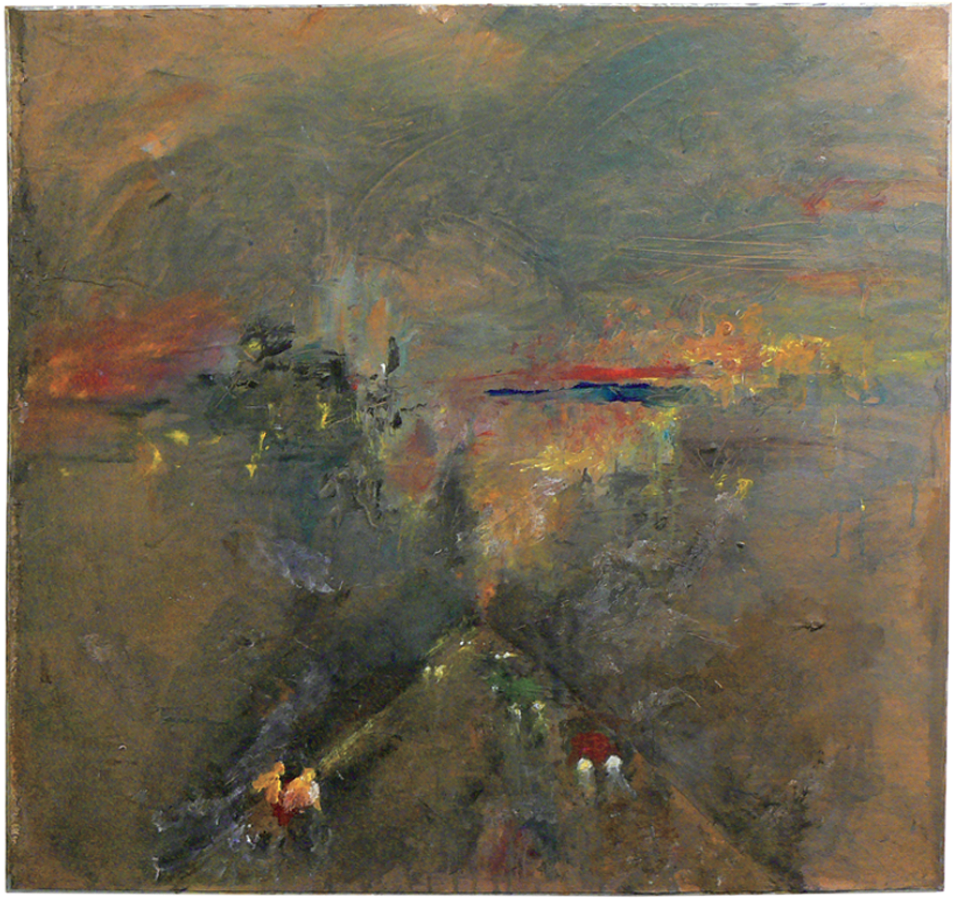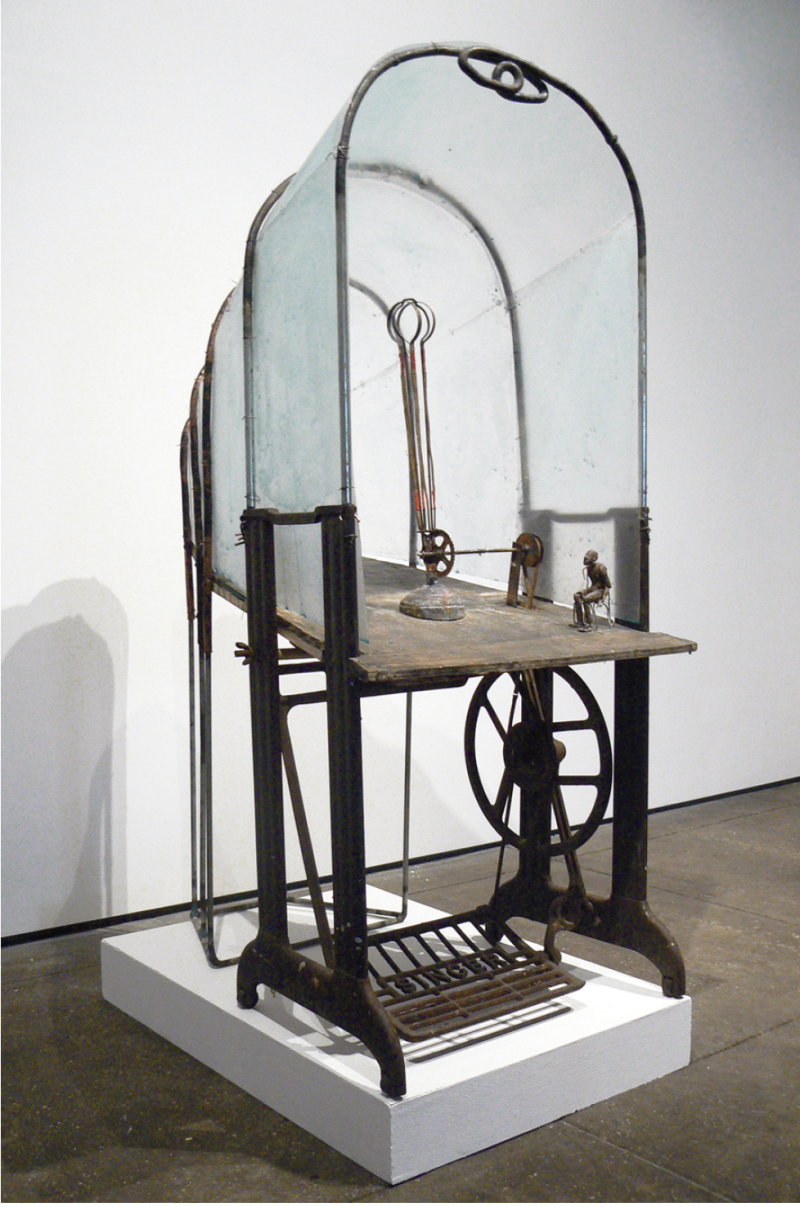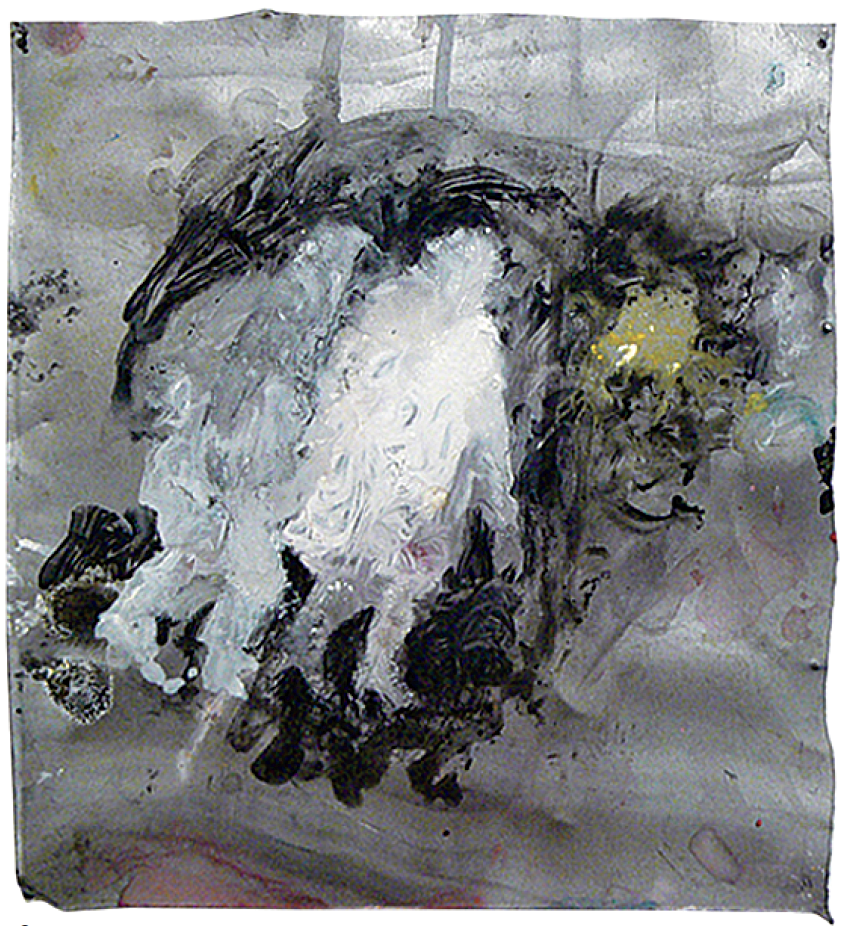June Leaf
When I arrived at the opening of “June Leaf: Recent Work” at the Edward Thorp Gallery in New York in December, the 82-year-old artist, sprightly and nimble, long, white hair flowing, had just jumped onto one of her new sculptural contraptions and had begun pedalling furiously, rattling the machine’s old iron gears as they turned. Along with her husband, American photographer Robert Frank, Leaf has divided her time between Nova Scotia and New York for some 40 years, and has accumulated a body of work that is singular both for its playfulness and its intense, tactile sensuality. But while Leaf’s work may have its quirky side, it is rarely merely lighthearted: the simple, corroded, fra-gile materiality of her sculptures, and the smoldering, golden-hour light of her paintings, give them a quality that is lyrical, uncanny and elegiac.

June Leaf. Second Avenue, 2011, acrylic on paper mounted on tin, 34 x 36”. Images courtesy Edward Thorp Gallery, New York.
In Untitled (Theater), 2010–2011, a diminutive metal figure sits gazing sidelong at what looks like a hybrid of a Surrealist monument and an ancient eggbeater. Above is a proscenium with pale turquoise canopy receding in perspective. Leaf’s curious mechanical theater may seem a descendent of the work of Alexander Calder and Jean Tinguely, but while Calder’s circus has a childlike gaiety and Tinguely’s philosophical machines are demonically self-destructive, Leaf’s construction is introspective and existential: the theater here is incredibly private, the small figure trapped and frightened. Leaf’s theater is a theater of the mind.
In Sleeping Woman, 2011, a woman pressed from tin and sparsely painted with acrylic is stretched out on her stomach on a narrow ledge welded to a thin tin sheet. The surface is crumpled, smudged, and stained, so that its muted, silvery sheen is moody and painterly. The sleeping woman is blissfully unaware of the precariousness of her position. For A Couple Walking, 2011, on the other hand, Leaf scumbled two figures, one white and one grey, walking close against a loosely brushed black background painted directly on the tin. The acrylic paint on the rumpled metal surface is quick and slippery, a smear of pink at the bottom and a daub of yellow suggesting that they are secretly stealing through encroaching night. The couple in A Couple Walking aren’t out for an evening stroll; they are fleeing.

June Leaf, Untitled (Theater), 2010–2011, mixed media, 53 x 23.25 x 36”.
Leaf’s work has a warm, inviting beauty; everything she makes almost begs to be touched. Her recent work is also suffused with a brooding and, at moments, apocalyptic anxiety. In Second Avenue, 2011, for instance, a work in acrylic on paper and mounted on tin, the avenue recedes back from the centre of the image’s lower edge, deep into the picture plane, daubs of white depicting the headlights of cars streaking toward the viewer. The cavernous city is built up on either side in layers of grey and dark foggy orange, the horizon—the tip of Manhattan and the harbour beyond—a blazing conflagration. It is hard to contemplate Second Avenue without thinking of September 11, 2001, and it also directly evokes Jean-Baptiste-Camille Corot’s great allegorical disaster painting, The Burning of Sodom, 1843, with its smoldering horizon and smoke-filled sky. Figures on a Spiral Staircase, 2010–2011, by contrast, is more overtly metaphysical. Rudimentary figures labour up a loosely gestural spiral staircase, a thick swatch of pulled orange, red and yellow forming a horizon in the centre; the background a muddy, turbulent blue sky. Near the top, the staircase dissolves into vertical strokes of glittering yellow, as though here the beleaguered figures cease climbing and simply ascend. And in Figure with an Angel, 2010–2011, the picture is framed by a wire arch at the top of which is a floating eye. Below is an enigmatic monument like the one in Untitled (Theater), drawn in a quavering flame-yellow against a chalked-in triangle, a red figure furiously turning the crank. The background is a sky agitated with light and cloud, and at the top of the monument, a phosphorescent white angel hovers. Figure with an Angel is a mysterious annunciation.
One of the dominant themes in Leaf’s recent work is ascent—and descent. In Spiral Staircase, 2011, the staircase, molded from lengths of wire, is set in an open tin box that recedes in perspective, like a trick room in a funhouse, the staircase shimmering on the box’s silver walls. In Figure Descending Staircase, 2010–2011, a small, emaciated figure (it resembles one of Giacometti’s tiny bronze figures) descends a staircase atop a tin wall in the shape of an organic whorl. In Figure Climbing Ladder, 2011, a tin figure is on the first rung of a narrowing ladder to nowhere; in Ladder, 2011, a beautifully oxide-green steel and copper ladder is simply propped up in mid-air. And in the stunning painting Figure Climbing Staircase, 2011, a white, silhouetted figure climbs a fragile squiggle of a staircase that begins nowhere and ends nowhere, the ground divided between earth-tones and an explosion of cloudy grey. Stairways, staircases and ladders are transition zones, whether physical or spiritual or both at the same time, but in Leaf what those levels or planes consist in is left wholly indeterminate. In Leaf’s work, we are always left suspended, as the anonymous 14th-century writer would have it, in a cloud of unknowing.

June Leaf, A Couple Walking, 2010–2011, acrylic on tin, 10 x 9.25”.
The scope and intensity of Leaf’s concerns create the illusion, even as one is viewing them, that they are massive in size, like Anselm Kiefer’s great Sefer Hechaloth, 2002, or The Heavenly Palaces, 2004, but in fact they are small, densely wrought, and very handmade. They don’t need to be monumental; they are microcosms that exist at every scale at once, and lead the viewer into interior spaces that are as private as they are vast. And, like Giacometti, in a way, Leaf has a dry sense of humour and of the absurd. In Untitled (Figure Cranking), 2011, a stooped figure holds the handle of a crankshaft connected to one of Leaf’s curious, homemade obelisks and to a big wheel underneath its platform, an elementary machine that circles in on itself and, in the end, doesn’t do anything we can really understand. One can easily imagine Leaf skittering across the gallery, hopping on and pedaling away, laughing at the figure’s useless and obsessive movements, its helplessness and bewilderment—and ours. ❚
“June Leaf: Recent Work” was exhibited at the Edward Thorp Gallery, New York, from December 15, 2011 to January 28, 2012.
Daniel Baird is a Toronto-based writer on art, culture and ideas.

